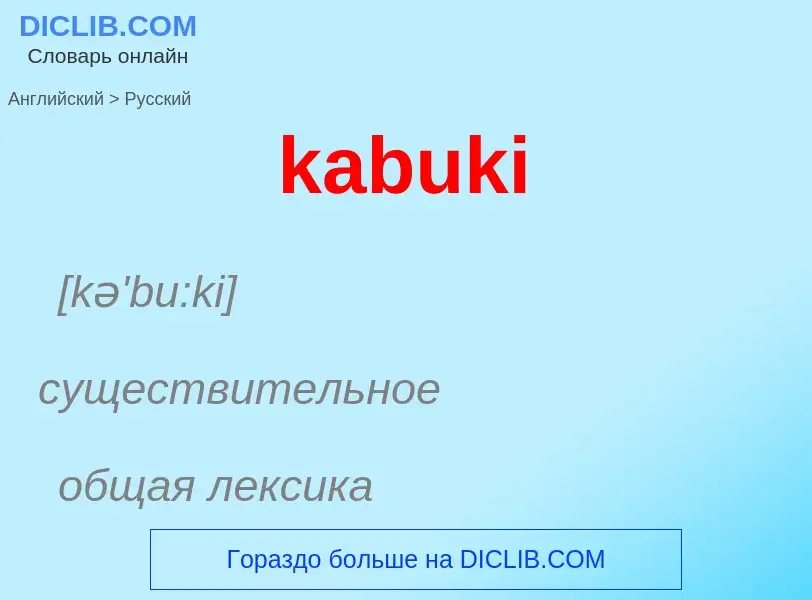Translation and analysis of words by ChatGPT artificial intelligence
On this page you can get a detailed analysis of a word or phrase, produced by the best artificial intelligence technology to date:
- how the word is used
- frequency of use
- it is used more often in oral or written speech
- word translation options
- usage examples (several phrases with translation)
- etymology
kabuki - translation to russian
[kə'bu:ki]
существительное
общая лексика
кабуки (вид японского театра)
['grændstændiŋ]
существительное
разговорное выражение
рисовка
поведение
рассчитанное на эффект
Definition
Wikipedia

Kabuki (歌舞伎, かぶき) is a classical form of Japanese theatre, mixing dramatic performance with traditional dance. Kabuki theatre is known for its heavily stylised performances, its glamorous, highly decorated costumes, and for the elaborate kumadori make-up worn by some of its performers.
Kabuki is thought to have originated in the early Edo period, when the art's founder, Izumo no Okuni, formed a female dance troupe that performed dances and light sketches in Kyoto. The art form later developed into its present all-male theatrical form after women were banned from performing in kabuki theatre in 1629. Kabuki developed throughout the late 17th century and reached its zenith in the mid-18th century.
In 2005, kabuki theatre was proclaimed by UNESCO as an intangible heritage possessing outstanding universal value. In 2008, it was inscribed in the UNESCO Representative List of the Intangible Cultural Heritage of Humanity.


![Kabuki Scene (Diptych) by [[Hokushu]] Kabuki Scene (Diptych) by [[Hokushu]]](https://commons.wikimedia.org/wiki/Special:FilePath/Brooklyn Museum - Kabuki Scene (Diptych) -85.282.6a- Hokushu.jpg?width=200)

![[[Yoshitsune Senbon Zakura]]}} [[Yoshitsune Senbon Zakura]]}}](https://commons.wikimedia.org/wiki/Special:FilePath/Kabuki-Play-Yoshitsune-Senbon-Zakura-1847.png?width=200)
![Exterior of [[Kabuki-za]] in Tokyo Exterior of [[Kabuki-za]] in Tokyo](https://commons.wikimedia.org/wiki/Special:FilePath/Kabuki-za Theatre 2013 1125.jpg?width=200)
![[[Chūshingura]]}} at Edo Nakamura-za theater [[Chūshingura]]}} at Edo Nakamura-za theater](https://commons.wikimedia.org/wiki/Special:FilePath/Kanadehon Chūshingura by Toyokuni Utagawa III.jpg?width=200)

![The earliest portrait of [[Izumo no Okuni]], the founder of kabuki (1600s) The earliest portrait of [[Izumo no Okuni]], the founder of kabuki (1600s)](https://commons.wikimedia.org/wiki/Special:FilePath/Okuni kabuki byobu-zu cropped and enhanced.jpg?width=200)
![Kabuki actors Bando Zenji and Sawamura Yodogoro; 1794, fifth month by [[Sharaku]] Kabuki actors Bando Zenji and Sawamura Yodogoro; 1794, fifth month by [[Sharaku]]](https://commons.wikimedia.org/wiki/Special:FilePath/SharakuTwoActors.jpg?width=200)

![[[Shibaraku]]}} at the Tokyo [[Kabuki-za]] theatre [[Shibaraku]]}} at the Tokyo [[Kabuki-za]] theatre](https://commons.wikimedia.org/wiki/Special:FilePath/Shibaraku, Kabukiza November 1895 production.jpg?width=200)

